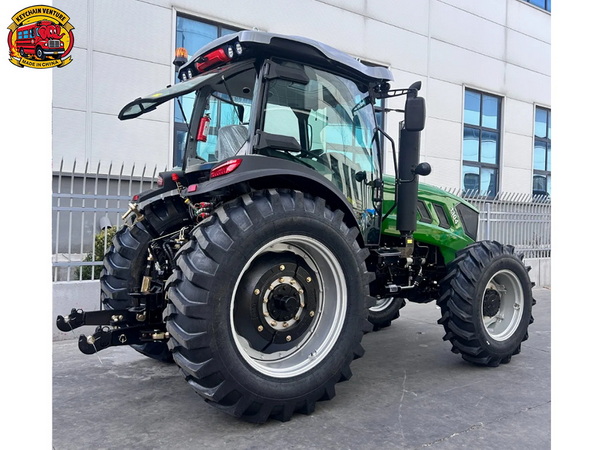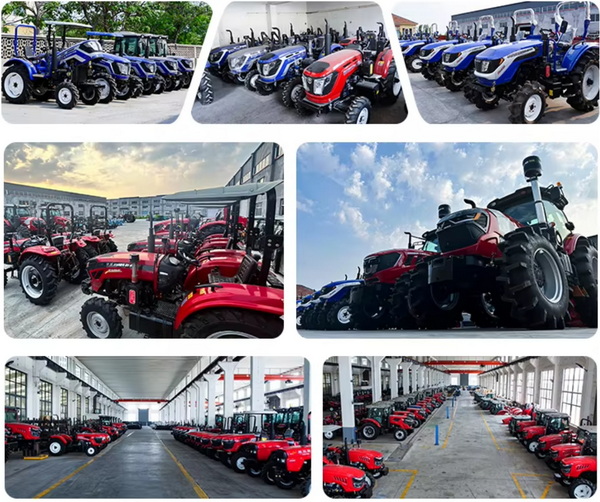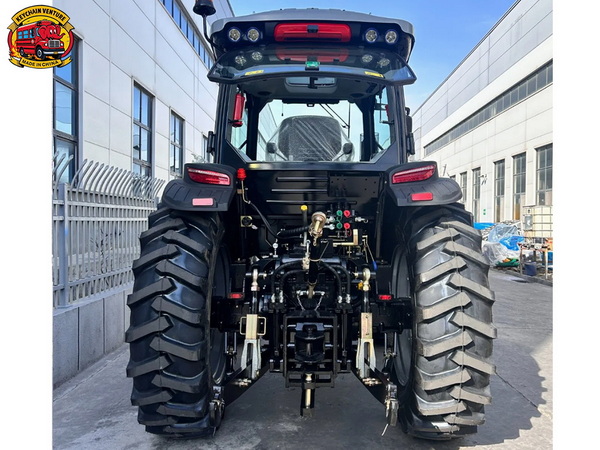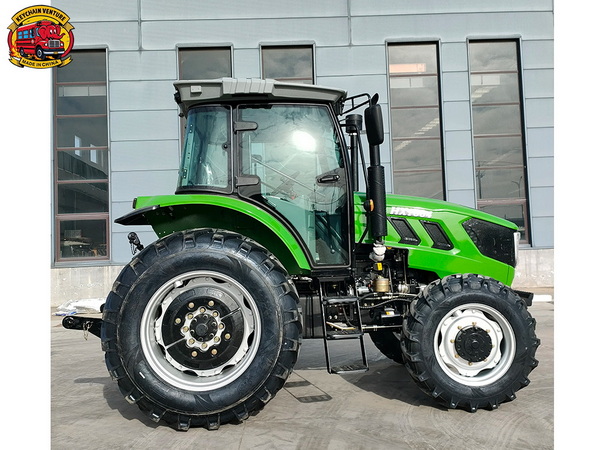Views: 222 Author: Amanda Publish Time: 2025-08-20 Origin: Site








Content Menu
● Understanding the Basics of Used Tractor Valuation
>> Key Concepts
● Major Factors Influencing Used Tractor Values
>> 2. Brand and Model Popularity
>> 4. Condition and Maintenance History
>> 5. Attachments and Accessories
>> 6. Market Demand and Regional Factors
>> 7. Engine Power and Specifications
● Step-by-Step Method to Find a Used Tractor's Value
>> Step 1: Gather Essential Information
>> Step 2: Use Online Valuation Tools
>> Step 3: Research Local Listings
>> Step 4: Consult Pricing Guides and Manuals
>> Step 5: Get a Professional Appraisal
>> Step 6: Adjust for Regional and Seasonal Variables
● Best Online and Offline Resources for Pricing Used Tractors
● Tips for Sellers and Buyers to Maximize Value
>> For Sellers:
>> For Buyers:
● How Market Trends Affect Used Tractor Pricing
● The Role of Documentation and Maintenance History
● Regional Differences in Used Tractor Prices
● Additional Considerations When Valuing a Used Tractor
>> 1. Insurance and Financing Impact
>> 2. Residual Value for Lease or Rent
>> 3. Environmental Compliance
>> 4. Availability of Replacement Parts
>> 1. How important is the engine hour reading in determining the value of a used tractor?
>> 2. Can attachments significantly increase the resale value of a used tractor?
>> 3. Are there standard pricing guides I should always use?
>> 4. How does regional demand impact a used tractor's price?
>> 5. Should I get a professional valuation for a used tractor?
When it comes to buying or selling a used tractor , one of the most important questions is: How do I find the value of a used tractor? Whether you are a farming professional, a commercial vehicle buyer, or simply someone interested in agricultural equipment, knowing the accurate value of a used tractor is crucial. It helps you negotiate better deals, understand market trends, and plan your investments wisely.
In this comprehensive guide, we will explore the key factors affecting the value of a used tractor, methodologies for valuation, trusted resources, and expert tips to ensure you get a fair price. As a leading Chinese commercial vehicle supplier, KeyChain Venture Co., Ltd. is committed to delivering high-performance tractors and trucks, so we understand the significance of valuing machines correctly.

A used tractor's value is determined by several interrelated factors that buyers and sellers must consider. Unlike brand-new tractors, used models have a range of depreciation, wear levels, and usage histories impacting their market worth.
Tractor valuation isn't simply based on the model year or brand. Instead, it involves assessing mechanical condition, hours used, attachments, maintenance, and market demand.
- Depreciation: The value decreases over time based on use and age.
- Fair Market Value (FMV): The price that a willing buyer and seller agree upon.
- Book Value: Often found in industry guides and pricing manuals.
- Trade-In Value: The amount a dealer offers to purchase your tractor.
Understanding these concepts helps both buyers and sellers align expectations realistically. Knowing the difference between trade-in value and fair market value, for example, enables you to negotiate from a strong position.
Several critical elements determine how much a used tractor is worth. Here are the most important factors:
Newer tractors generally have higher values. However, some older models may retain value better if they are known for durability or special features. For instance, models with proven engines or classic designs often have enthusiasts willing to pay a premium.
Certain brands have better reputations, reliability, and parts availability. Well-known brands like John Deere, Kubota, and New Holland typically hold their value better. Brand prestige influences perceived quality and ease of future maintenance, affecting resale price.
Hours are like mileage for tractors. Lower hours typically mean less wear, resulting in higher value. Tractors running more than 3,000-5,000 hours may see accelerated depreciation unless serviced meticulously.
Tractors that are regularly serviced and kept in good condition command higher prices. Look for service records, recent repairs, any modifications, and signs of wear or rust. A well-documented maintenance history signals reliability.
Additional equipment like loaders, mowers, backhoes, and specialized implements increase the tractor's overall worth. Having compatible and well-maintained attachments adds versatility and convenience for prospective buyers.
Local agricultural needs, climate, and economic conditions influence pricing. Seasonal fluctuations also matter; demand peaks during planting and harvesting seasons often drive prices up.
Higher horsepower tractors often have more value, especially for commercial users needing power for heavy-duty tasks. However, for smaller farms or specific jobs, a mid-range horsepower tractor may be more desirable.
Tractors equipped with modern technology such as GPS, automatic steering, fuel-efficient engines, and digital monitoring systems tend to preserve value more effectively. Buyers today are looking for efficiency-improving features.

To confidently find the value of a used tractor, follow these practical steps:
Record the tractor's make, model, year, engine hours, condition, and any accessories. Note down known issues or modifications. A clear profile allows consistent comparison.
Several websites provide instant price estimates based on your input. While not perfect, these tools give a reliable baseline. Examples include agricultural equipment pricing websites and dealer appraisal forms.
Check classified ads, auction sites, and dealership offers to see asking prices for similar tractors. Pay attention to prices achieved in completed sales rather than just asking prices for a more accurate picture.
Publications like the National Automobile Dealers Association (NADA) guide or TractorData.com offer standard pricing ranges. These guides analyze factors like depreciation and regional trends.
Especially for high-value tractors, a professional inspection ensures accuracy. Experts can evaluate hidden mechanical issues or potential future costs.
Modify your estimate based on local demand, seasonal farming cycles, and weather-related factors. Such adjustments reflect reality better than a one-size-fits-all price.

Various online resources and offline references help you pinpoint the right value:
- TractorData.com: Comprehensive specs and pricing based on historical data.
- NADA Guides: Industry-standard prices for agricultural and construction equipment.
- Machinery Pete: Detailed market analysis, auction results, and trend reports.
- Local Dealer Websites: Look at trade-in and sale prices to understand dealer valuations.
- Agricultural Equipment Auctions: Auction results provide real market price indicators.
- Industry Associations and Agricultural Journals: Occasionally publish pricing indexes and market insights.
These resources, when used collectively, provide a multi-angle perspective to estimate accurate tractor values.
- Maintain detailed service logs proving consistent upkeep.
- Clean and prepare the tractor with cosmetic repairs to enhance appeal.
- Highlight attachments, recent part replacements, or upgrades.
- Sell during peak agricultural seasons to attract motivated buyers.
- Be transparent about any damage or wear; honesty builds trust and may prevent negotiation stalls.
- Perform a thorough inspection or hire a professional mechanic.
- Compare similar listings in your region to avoid overpaying.
- Negotiate based on hours, condition, and market factors.
- Verify tractor identification numbers (VIN) and maintenance history to avoid surprises.
- Consider total cost of ownership, including any necessary immediate repairs.
The price of used tractors is influenced by broader market and economic trends. For example:
- Commodity Prices: Higher crop prices often increase farmers' purchasing power, driving up used tractor demand.
- Government Subsidies: Incentives for mechanization or farming upgrades can raise local demands.
- Fuel Prices: Diesel cost fluctuations impact operating costs and influence resale value.
- Technological Innovation: Introduction of new models with superior fuel efficiency or automation often pushes older models' values down.
- Global Supply Chain: Disruptions or tariffs can affect availability of parts and new tractors, making used tractors more valuable.
Monitoring these trends helps buyers and sellers time transactions for optimal value.
Tractors accompanied by complete service records, receipts, and certifications display transparency and reliability, often resulting in a premium price. Documentation validates claimed hours and repairs and may prove that manufacturer-recommended maintenance schedules were followed.
Neglecting maintenance or lacking proof thereof can drastically reduce value or make potential buyers wary.
Tractor values vary significantly by geography. Factors influencing regional pricing include:
- Agricultural Intensity: Areas with extensive farming tend to have higher demand.
- Climate: Tractors used in harsh or wet climates may have greater wear.
- Infrastructure and Accessibility: Remote regions may have fewer buyers, lowering prices.
- Local Economies: Wealthier farming communities generally offer better resale returns.
- Regulatory Requirements: Different emission or safety standards can affect usability and value.
When evaluating a used tractor, always adjust your expectations to the region's dynamic.
The tractor's value also affects insurance premiums and financing options. Accurate valuation ensures adequate coverage and helps in securing favorable loans.
Understanding a tractor's used value aids lessors in setting lease payments and estimating end-of-lease valuations.
Older tractors may face restrictions under newer environmental laws, particularly regarding emissions. Non-compliant tractors might have reduced values or limited usability.
The ease of sourcing parts influences a tractor's longevity and thus its market value. Models with discontinued production or expensive parts tend to depreciate faster.
Finding the value of a used tractor involves a detailed consideration of multiple factors: age, brand reputation, hours of operation, condition, attachments, and fluctuating market conditions all play crucial roles. Employing a combination of online tools, price guides, local market research, and, when needed, professional appraisals, equips buyers and sellers with realistic and fair valuations.
Remember that transparency, documentation, and timely maintenance not only preserve but can enhance a used tractor's value. By understanding regional variances, technological trends, and economic factors, you can successfully navigate the complex market of used tractors to make informed, strategic commercial decisions.

The engine hour reading is crucial as it reflects the machine's usage intensity. Lower hours typically mean less wear and higher resale value, but condition and maintenance history also matter.
Yes, attachments such as loaders, backhoes, and mowers enhance the tractor's versatility and usability, often translating into higher sale prices.
Guides like NADA and TractorData.com provide important reference points but should be used alongside current market research for the most accurate valuation.
Local farming activity, economic conditions, and climate affect demand and availability, causing significant regional price variation.
For high-value or specialized tractors, a professional appraisal ensures an accurate assessment of mechanical and cosmetic conditions, reducing risk in transactions.